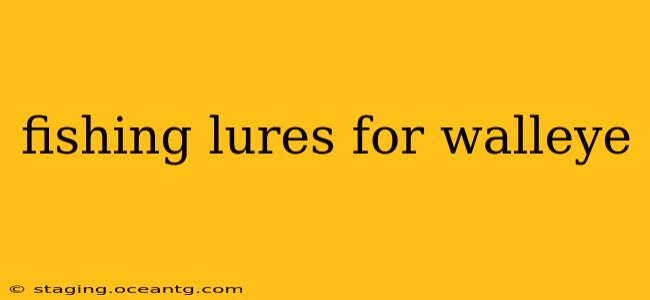Walleye, prized for their delicious flesh and challenging fight, are a favorite target for anglers across North America. Catching these elusive predators requires understanding their feeding habits and employing the right lures. This guide dives deep into the world of walleye fishing lures, exploring various types, techniques, and considerations to help you land more of these prized fish.
What are the Best Lures for Walleye?
The "best" lure is highly dependent on factors like water clarity, time of year, and the specific location. However, several lure types consistently produce results. These include:
-
Crankbaits: These versatile lures mimic injured baitfish, triggering aggressive strikes. Deep-diving crankbaits are effective in deeper water, while shallow-running models work well in shallower areas. Choose crankbaits in colors that match the prevalent baitfish in the area – often silver, gold, or chartreuse.
-
Jigging Spoons: These spoons, with their flashy action, are excellent for vertical jigging. Their weight allows for precise depth control, making them ideal for targeting walleye holding on structure. Try spoons in silver, gold, or bright colors like chartreuse or orange.
-
Spinnerbaits: The combination of a spinning blade and a trailer creates an enticing flash and vibration that attracts walleye from a distance. Spinnerbaits are particularly effective in stained or murky water. Consider using spinnerbaits with larger blades for deeper water and smaller blades for shallower areas.
-
Soft Plastics: Twisters, grubs, and creature baits are extremely effective, especially when rigged on jigs. Their lifelike action and ability to be fished in various ways make them a go-to option for many walleye anglers. Choose colors that mimic natural prey – crayfish, minnows, or leeches.
-
Blade Baits: These lures feature a spinning blade that creates vibration and flash, attracting walleye from afar. Their versatility and ease of use make them a solid choice for anglers of all skill levels.
What Color Lures Work Best for Walleye?
Walleye sight is highly sensitive to light, and their color preferences shift based on water conditions and time of day.
-
Clear Water: Natural colors like silver, gold, and subtle patterns often work best.
-
Murky Water: Brighter colors like chartreuse, orange, and pink become more effective. These colors stand out more in low-visibility conditions.
-
Low-Light Conditions: Glow-in-the-dark or UV-reactive lures can be highly effective when fishing at dawn, dusk, or at night.
What Size Lures Are Best for Walleye?
The ideal lure size depends on the size of the walleye you're targeting and the size of the baitfish in the area. Generally, lures ranging from 1/8 to 3/4 of an ounce are suitable for most walleye fishing scenarios. Larger lures are best for targeting larger walleye or in deeper water, whereas smaller lures are ideal for shallower water or when targeting smaller fish.
What is the Best Technique for Using Walleye Lures?
The most effective technique depends heavily on the lure type and the specific fishing situation. However, some common techniques include:
-
Casting and Retrieving: This is a popular method for crankbaits, spinnerbaits, and blade baits. Varying your retrieve speed can significantly impact your success.
-
Jigging: This technique is ideal for jigs tipped with soft plastics or used with jigging spoons. A slow, rhythmic jigging motion is usually most effective.
-
Trolling: Trolling allows you to cover vast areas and is especially effective when targeting walleye in open water.
How Deep Should I Fish for Walleye?
Walleye can be found at various depths, depending on the time of year, water temperature, and available cover. In spring and fall, they may be found shallower, while in summer they often move to deeper, cooler water. Utilize depth finders to locate walleye holding near structure like drop-offs, weed beds, and rocks.
What are the Best Locations to Catch Walleye?
Walleye are often found near structure that provides cover and ambush points. Look for areas such as:
-
Drop-offs: The edges of drop-offs are prime locations where walleye lie in wait for unsuspecting prey.
-
Weed beds: Walleye often hold near weed edges, especially during the spawning season.
-
Points and shorelines: These areas often provide cover and access to feeding areas.
-
Deep holes and reefs: Walleye will also congregate in deeper water, especially during the summer months.
This comprehensive guide provides a strong foundation for selecting and employing the right lures for walleye fishing. Remember, success comes from understanding your target species, adapting to changing conditions, and experimenting with different techniques and lure combinations. Tight lines!
